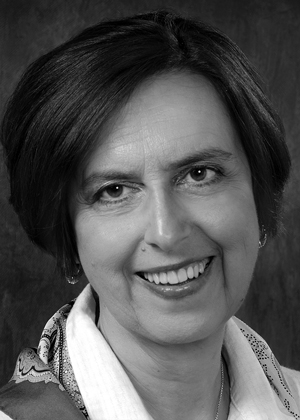Citation
For Anne Mee Thompson, dedicated scientist and generous colleague, winning the Roger Revelle Medal has the air of poetry. For 4 decades, Anne has been making sustained, essential contributions to the advancement of our understanding of interactions between the composition of the troposphere and climate. She has held leadership roles in globally influential organizations such as the international Commission on Atmospheric Chemistry and Global Pollution, the International Association of Meteorology and Atmospheric Sciences, and the International Ozone Commission. Along the way, she found time to introduce countless young people to the wonders of science and urgency of protecting our fragile environment and for a stint at president of the Atmospheric Sciences section of the American Geophysical Union (AGU).
Early in her career, Anne held appointments at the Woods Hole Oceanographic Institution and at the Scripps Institution of Oceanography when Roger Revelle was still an inspiring presence. With mentoring from Oliver Zafiriou and Ralph Cicerone, Anne left a mark in marine atmospheric studies of the cycling of formaldehyde and reactive free radicals and later at NASA Goddard Space Flight Center showed that satellite data can be used to estimate fluxes of biogenic sulfur compound involved in climate-chemical feedbacks.
Anne has led the way on studying and shaping our understanding of the atmosphere’s ability to cleanse itself, linking chemical changes to climate perturbations. She addressed satellite observations of tropospheric ozone and air quality over the ocean on several cruises, including on R/V Akademik Korolev, where she assembled a suite of trace gas measurements demonstrating the utility of ship-based observations for evaluation of remotely sensed data.
Anne’s research on ozone in the remote troposphere involved work in locations as diverse (and sometimes inhospitable) as Arctic Canada, Mexico, Panama, Ireland, Greece, Japan, and southern Africa. Her ozonesonde networks, most notably Southern Hemisphere Additional Ozonesondes (SHADOZ), provided data for hundreds of researchers and helped the ozonesonde achieve its highest level of precision since its introduction in the 1960s. Throughout these efforts Anne has been a constant inspiration to students and postdocs at the Pennsylvania State University and the University of Maryland, as well as entraining and inspiring scientists from underrepresented groups in the developing world, including many women.
In a career that in some ways parallels that of Roger Revelle, Anne Thompson’s scientific contributions and exceptional achievements in the area of Earth observations, from ground to space, especially trace gases in the tropics, make her a fitting winner of AGU’s 2015 Roger Revelle Medal.
—Russell Dickerson, University of Maryland, College Park
Response
Thanks to you, Russ, and to the Revelle Committee for this honor. When something like the Revelle happens, one is humbled to think of the people who share in the scientific achievements the medal represents. You mentioned Ollie Zafiriou and Ralph Cicerone, who turned a photochemist into an atmospheric scientist. When it was time to leave postdoc life, Rich Stolarski and Marv Geller brought me to the Atmospheric Chemistry and Dynamics Branch at NASA Goddard. Career advice in the mid-1980s proved true: “Do good science, try new ideas; the rest will follow.” It was easy to discover links between tropospheric trace gases and diverse aspects of the Earth system—ocean biology, fires, and ice cores—when colleagues were trying out-of-the-box approaches to solve the Antarctic ozone hole. Part of the satisfaction of interdisciplinary research was working with remarkable people across Goddard, at universities, and with the National Oceanic and Atmospheric Administration and U.S. Environmental Protection Agency.
Something was missing in that early work; we were running a lot of models with almost no data. A turning point came in the 1990s. On the Third Soviet-American Gas and Aerosols cruise, for example, we tested photochemical theory with new instruments in the pristine tropical Pacific atmosphere. Everything worked (!), and I was initiated into the exciting world of international experiments. Transport and Atmospheric Chemistry Near the Equator–Atlantic (TRACE-A)/Southern African Fire-Atmosphere Research Initiative (SAFARI-92) quickly followed, beginning long collaborations with African and Brazilian colleagues. Our data improved satellite algorithms and proved that lightning, not just fires, causes an ozone maximum in the tropical Atlantic. The SHADOZ ozonesonde network took off in 1998, thanks to dedicated operators who continue to turn out high-quality data, often under hard conditions.
Eight and half years as a Penn State meteorology professor (for which I thank Bill Brune) widened intellectual horizons and showed the joy of learning from bright students. In turn, I challenged them to embrace the NASA mission and public service. One Penn State graduate, Goddard’s John Yorks, already has an instrument on the International Space Station.
How lucky I was to join Goddard again, in 2013, recruited by Bill Lau, Jose Rodriguez, and Jim Gleason. Besides working with amazing satellite data, I spend time filling gaps in global networks, recruiting talent, and strategizing new missions. Roger Revelle, who made Scripps a great climate center, provided the funds to start Dave Keeling’s Mauna Loa carbon dioxide record. Isn’t that the most important part of this medal? It reminds all of us to keep Earth observations strong in challenging times.
—Anne M. Thompson, NASA Goddard Space Flight Center, Greenbelt, Md.
Citation: AGU (2015), Anne M. Thompson receives 2015 Roger Revelle Medal, Eos, 96,doi:10.1029/2015EO041301. Published on 28 December 2015.
Text © 2015. The authors. CC BY-NC 3.0
Except where otherwise noted, images are subject to copyright. Any reuse without express permission from the copyright owner is prohibited.

